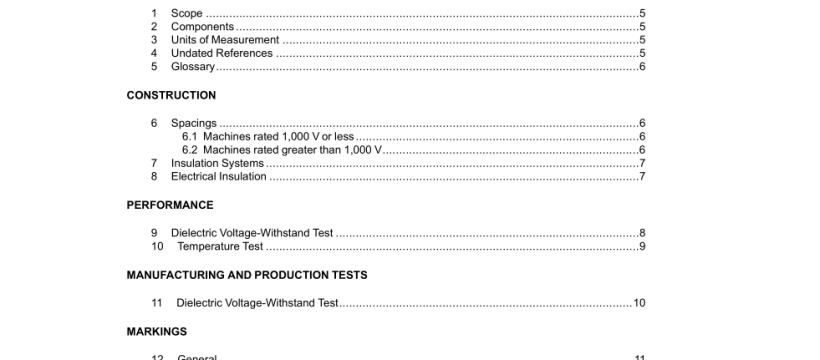UL 1004-9-2021 pdf download.Form Wound and Medium Voltage Rotating Electrical Machines.
1.2 For the purposes of this Standard, the term “machine” is representative of and equivalent to the terms rotating electrical machine and rotating machine, and is understood to mean all manner of electric motors and generators covered by the scope of this Standard. The term “machine” is understood to apply to both AC and DC machines. 1.3 These requirements apply to field-installed machines with form wound windings and rated for applications between 460 Vand up to 34,000 V. 1.4 This standard also applies to field-installed machines employing random wound windings and rated for applications above 1,000 Vand up to 7,200 V. 1.5 Machines intended for use in hazardous locations as defined in the National Electrical Code, NFPA 70, may have additional requirements to be met as specified in the National Electrical Code, NFPA 70. 1.6 These requirements do not cover sealed (hermetic type) motor-compressor parts, which are evaluated under the Standard for Household and Similar Electrical Appliances, Part 2: Particular Requirements for Motor-Compressors, UL 60335-2-34.
7 Insulation Systems 7.1 Insulation systems shall comprise materials that have been shown by service life experience or test to have suitable thermal endurance when operating at the temperature limit declared. Compliance shall be demonstrated by one of the following methods: a) Insulation systems without suitable field experience may be used provided the insulation system in question (candidate system) complies with Procedure C – Single-point thermal ageing test in IEC 61858 – Part 2: Electrical insulation systems – Thermal evaluation of modifications to an established electrical insulation system (EIS) – Part 2: Form-wound EIS, when tested against a system previously found to be acceptable for service at the rated temperature class; b) A modified or a new insulation system complying with the requirements of IEC 60034-18-31, Part 18-31: Functional evaluation of insulation systems – Test procedures for form-wound windings – Thermal evaluation and classification of insulation systems used in rotating machines; c) For form wound machines rated 15,000 V or less, using IEEE 1776, Recommended Practice for Thermal Evaluation of Unsealed or Sealed Insulation Systems for AC Electric Machinery Employing Form-Wound Pre-Insulated Stator Coils for Machines Rated 15000 V or Below, is considered to meet the intent of this requirement; or d) The manufacturer’s declaration with supporting documents such as test reports to established standards and documentation of machines using the materials with service life experience reports.
10 Temperature Test 10.1 The Temperature Test is to be conducted with the machine under test supplied with rated voltage and delivering full rated output power multiplied by any service factor. Exception No. 1: Alternatively, the machine may be tested using any ofthe test methods described in IEC 60034-29, Rotating electrical machines – Part 29: Equivalent Loading and Superposition Techniques – Indirect Testing, or test methods under the Temperature Test of IEEE 112, Standard Test Procedure for Polyphase Induction Machines and Generators. Exception No. 2: For motors greater than 500 hp where the test cannot be conducted at rated output, the tests can be conducted at points below rated load to extrapolate a calculated temperature rise at rated output. Exception No. 3: Othermethods ofloading the machine and measuring temperatures may be employed if found to yield equivalent results. 10.2 The Temperature Test is to be conducted until thermal stabilization is attained. Following stabilization, the temperatures on the windings shall not exceed the maximum temperatures specified in Table 10.1. Temperatures may be measured using the thermocouple, RTD/ETD, or the change-of- resistance method.
12 General 12.1 A machine shall be marked to indicate: a) Manufacturer’s name or identification; b) Machine catalog or model number; c) Rated voltage; d) Full-load amperes, watts or kilowatts, or both; e) Rated speed; f) Rated output; g) Rated ambient temperature, if other than 40°C (104°F); h) Rated frequency – expressed in one of the following terms: hertz, Hz, ac-dc, (frequency in Hz)/dc (for example, 60 Hz/dc), or ac only – or direct current; and, for a machine intended for use on a polyphase circuit, number of phases; i) If greater than 1, number of phases; j) The altitude if designed to operate at greater than 1000 m (3,280 feet); and k) Class of insulation system. 12.2 Machines are not prohibited from including a rated temperature rise or an insulation system class rise based on the maximum temperature observed during the Temperature Test. 12.3 Machines shall clearly identify the intended operating cycle.UL 1004-9-2021 pdf download.
UL 1004-9-2021 pdf download
